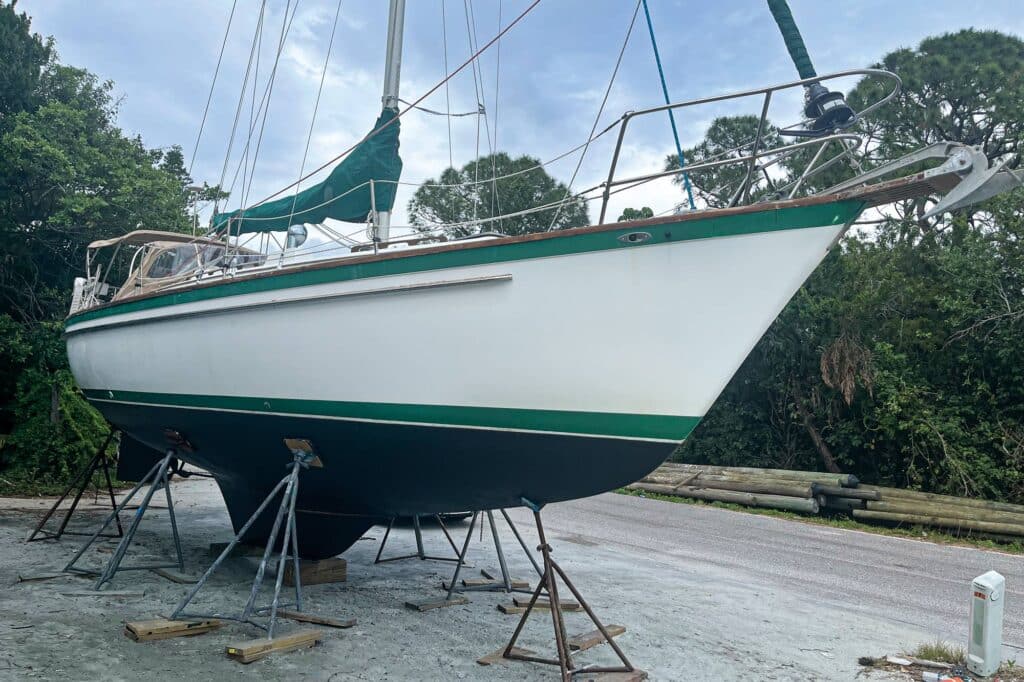
Sometimes I get the feeling that I’ve spent more time working on boats out of the water, below their waterline, than I’ve spent actually sailing them. That’s because for New England-based sailors like myself, every fall, our yachts get hauled for the winter and then require a fresh coat of bottom paint before returning to the drink the following spring. For me, this seasonal rite of passage has gotten a bit easier since the old days when I spent hours with a longboard sanding the bottom of my J/24 racer to get that smooth-as-silk racing edge. But all the cruising boats I’ve owned since then still require prep and paint, and it’s an annual task I’ve learned to tolerate—barely—in the same way I grit my teeth for my yearly physical with the doctor.
But all that changed when I bought my Pearson 365, August West, on the Gulf Coast of Florida. At first, I was astonished to learn that lots of boats spend multiple seasons without fresh bottom paint, opting instead to hire a diver for regular scrubs to keep marine growth to a minimum. For the first few months last winter, that was my go-to solution. But it was a stopgap measure, to say the least, as my diver, Casey, sent me text messages after every cleaning with an update on his work. After the third time my report card came back “Paint: poor,” I contacted the previous owner, wondering when the boat was last hauled and painted. When he basically couldn’t remember, I knew the time had arrived for the inevitable.
Back home in Rhode Island, the sanding and painting was always a job I’d tackled myself. In Florida, I quickly discovered there wasn’t a boatyard in greater Sarasota, near my boat’s slip on Longboat Key, that permitted owners to wield a sander or roller. On top of that, the closest yard to my boat, in nearby Cortez, didn’t even work on sailboats. But its team was good enough to recommend a neighboring facility, N.E. Taylor Boat Works, that was up for the task.
Related: Selecting Right Bottom Paint for Your Boat
As the pelicans fly, it’s only about 5 nautical miles from my dock to Taylor’s Travelift, mostly along the well-marked stretch of Intracoastal Waterway snaking through Sarasota Bay. However, the last little bit, up a narrow channel outlined with old, painted green markers into Cortez Cove, was a bit of a maze, and of course I ran aground in full view of one of the funky little town’s waterfront restaurants. Though I was ultimately able to extricate myself without assistance, I provided about 45 minutes of free entertainment to the dinner crowd. You’re welcome.
It also turned out that the previous paint job had been commissioned by the staff of Practical Sailor, a popular how-to newsletter about gear and maintenance. I was able to contact the editor, who helpfully told me the brand of ablative paint that had been applied, along with some other useful advice. He was curious to know how it had held up over the years, and I was happy to send him the “before” shot once the boat was hauled and blocked. The answer to his question? Not well.
The crew at N.E. Taylor, however, could not have been more welcoming or professional, and as long as they had the boat, I ended up getting some other work done, particularly the installation of two new deck hatches to replace the pair that had long ago given up the ghost.
So, I’m happy to report that August West returned to its slip with a spanking new paint job that should last me—fingers crossed—at least a couple of years. In the meantime, I’m hoping for high marks from Casey the next time he dons his wetsuit and takes the plunge.









